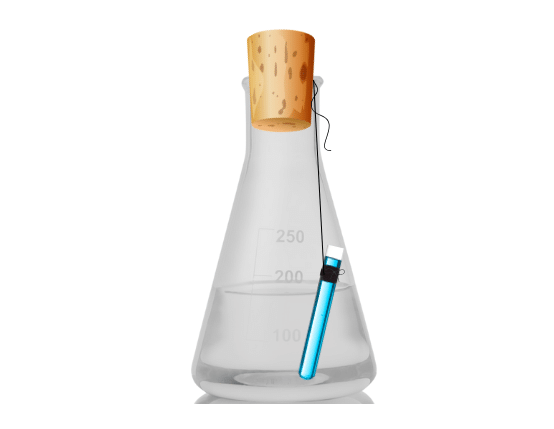1. Complete Activity 3.1 (Page 26).
• Take one of the following sets, X and Y of chemicals—
X Y
(i) copper sulphate sodium carbonate
(ii) barium chloride sodium sulphate
(iii) lead nitrate sodium chloride
• Prepare separately a 5% solution of any one pair of substances listed under X and Y each in 10 mL in water.
• Take a little amount of solution of Y in a conical flask and some solution of X in an ignition tube.
• Hang the ignition tube in the flask carefully; see that the solutions do not get mixed. Put a cork on the flask (see Fig. 3.1).
• Weigh the flask with its contents carefully.
• Now tilt and swirl the flask, so that the solutions X and Y get mixed.
• Weigh again.
• What happens in the reaction flask?
• Do you think that a chemical reaction has taken place?
• Why should we put a cork on the mouth of the flask?
• Does the mass of the flask and its contents change?
Answer:
Aim: To mix copper sulphate and sodium carbonate, note the observations and make the necessary conclusions.
Materials Required: Copper sulphate, sodium carbonate, conical flask, ignition tube, water.
Procedure:
(i) A 5% solution of copper sulphate is prepared in 10 mL water.
(ii) A 5% solution of sodium carbonate is prepared in 10 mL water.
(iii) A little amount of sodium carbonate is taken in a conical flask and a little amount of copper sulphate solution is taken in an ignition tube.
(iv) The ignition tube is hung in the flask carefully, taking care that the solutions do not get mixed.
(v) A cork is put on the flask.
(vi) The flask and its contents are weighed carefully.
(vii) Now the flask is tilted and gently swirled, so that the contents get mixed well.
(viii) The flask and its contents are weighed again.
(ix) The observations in the reaction flask are noted and the necessary conclusions are made.
Observations:
- Initially the flask and its contents weighed X grams.
- After the reaction, the flask and its contents also weighed X grams.
- A green coloured precipitate is observed after the reaction is completed.

Conclusions:
- A chemical reaction has taken place as indicated by the green precipitate of copper carbonate. The contents have changed.
- The mass before and after a reaction stays the same. This is accordance with the law of conservation of mass which states that, “Mass can neither be created nor destroyed in a chemical reaction.”
- We should put a cork on the mouth of the flask to prevent gas from escaping. If the gas escapes then the mass obtained after the reaction would be less than the initial mass. In order to get an accurate reading the gas must be trapped within the flask with the cork.
“• Take one of the following sets, X and Y of chemicals—
X Y
(i) copper sulphate sodium carbonate
(ii) barium chloride sodium sulphate
(iii) lead nitrate sodium chloride
• Prepare separately a 5% solution of any one pair of substances listed under X and Y each in 10 mL in water.
• Take a little amount of solution of Y in a conical flask and some solution of X in an ignition tube.
• Hang the ignition tube in the flask carefully; see that the solutions do not get mixed. Put a cork on the flask (see Fig. 3.1).
• Weigh the flask with its contents carefully.
• Now tilt and swirl the flask, so that the solutions X and Y get mixed.
• Weigh again.
• What happens in the reaction flask?
• Do you think that a chemical reaction has taken place?
• Why should we put a cork on the mouth of the flask?
• Does the mass of the flask and its contents change?” – Solved.
Related Links:
Solution to Group Activity
Solution to Activity 3.1
Solution to Activity 3.2
Solutions to Chapter 3 Atoms and Molecules


